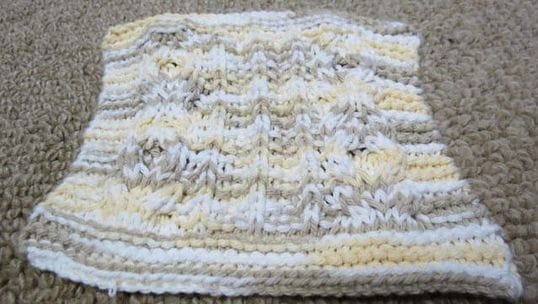Sentry Page Protection
Tip Store: Crafts & Hobbies: Knitting
More Info on Slipper Socks
Ever since the instructions came out on how to make the socks I have been busy knitting. I make on average 5 pairs a week. So far I have donated 300 pairs of socks to charity. However being a pensioner I was finding buying the yarn was becoming expensive. Now I go to my local op shops and get my yarn/wool from there. I pay 0.50c for a small ball, $1.00 for a large and $2.00 for an extra large. My charities now see me coming and ask "more socks please". I'm one happy knitter.
Contributed by Cherie Meredith
Contributed by Cherie Meredith
Slippersox
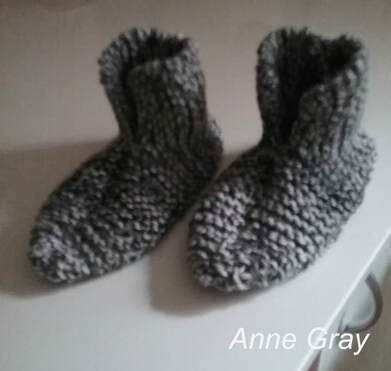
This pattern only costs around $3.00 or under to make, very easy and quick; I have made 100s over the years.
Materials:
24ply yarn - 3 x 8ply together
7mm needles or round about
Cast on 41 stitches
1st row: knit 15 purl 1, knit 9 ,purl 1, knit 15
2nd row: knit all stitches
Rep last 2rows 7 times
Cast off 7 stitches next 2 rows
Next row: Knit 8 purl 1 knit 9, purl 1, knit 8
Knit next row
Repeat last 2 rows 7times
Knit 5 knit 2 tog to end
Knit row
Knit 4 knit 2 tog to end
Knit row
Continue until knit 1 knit 2 tog has been done
Knit row
8 stitches left
Break of yarn with a long thread. Take wool through the stitches on the needle, pull tight and sew up.
Make one more.
Contributed by Anne Gray
Materials:
24ply yarn - 3 x 8ply together
7mm needles or round about
Cast on 41 stitches
1st row: knit 15 purl 1, knit 9 ,purl 1, knit 15
2nd row: knit all stitches
Rep last 2rows 7 times
Cast off 7 stitches next 2 rows
Next row: Knit 8 purl 1 knit 9, purl 1, knit 8
Knit next row
Repeat last 2 rows 7times
Knit 5 knit 2 tog to end
Knit row
Knit 4 knit 2 tog to end
Knit row
Continue until knit 1 knit 2 tog has been done
Knit row
8 stitches left
Break of yarn with a long thread. Take wool through the stitches on the needle, pull tight and sew up.
Make one more.
Contributed by Anne Gray
How to Tell Pure Wool Yarn from Synthetics
Approximate $ Savings: $20 - $40 per project
When you need some wool for a project look in the op shops first. Don't be put off if labels are missing from the balls though, there is a simple way to tell if the yarn is real wool or synthetic. Buy a ball, or negotiate with staff to cut a small strand from the end of a ball. Take it outside, out of the wind, and burn the end of the strand. You only need to burn an inch or two and I keep a box of matches in my car for this purpose. If it is wool it will form a small ball of carbon on the end that smells like burnt hair and crumbles like a burnt match head. If it is synthetic it melts instead, leaving a hard, plastic feeling ball. You haven't lost much if it isn't what you need. Usually only about 50c if you buy the ball and you can probably find a use for it anyway. If it is what you need you can scoop up the rest of the batch in confidence at a great price. For enough wool to make an average project you can easily save $20 - $40 by buying from the op shop rather than new, just because of labels. I recently bought 8 large balls for a felting project, so it had to be 100% wool, for $7!
Contributed by Lisa Docherty
When you need some wool for a project look in the op shops first. Don't be put off if labels are missing from the balls though, there is a simple way to tell if the yarn is real wool or synthetic. Buy a ball, or negotiate with staff to cut a small strand from the end of a ball. Take it outside, out of the wind, and burn the end of the strand. You only need to burn an inch or two and I keep a box of matches in my car for this purpose. If it is wool it will form a small ball of carbon on the end that smells like burnt hair and crumbles like a burnt match head. If it is synthetic it melts instead, leaving a hard, plastic feeling ball. You haven't lost much if it isn't what you need. Usually only about 50c if you buy the ball and you can probably find a use for it anyway. If it is what you need you can scoop up the rest of the batch in confidence at a great price. For enough wool to make an average project you can easily save $20 - $40 by buying from the op shop rather than new, just because of labels. I recently bought 8 large balls for a felting project, so it had to be 100% wool, for $7!
Contributed by Lisa Docherty
Make Your Own Pompons
Pompoms are used in lots of crafts and they put the finishing touch to beanies and bonnets and they are so easy to make. Step 1. Cut two small cardboard circles with a hole in the middle (about 5cm diameter outside and 1cm on the inside). Step 2. Wrap yarn around the circles until very full. Step 3. Then cut around the edge of the circle, where the two cardboard circles meet. Step 4. Tie a piece of yarn tightly between the two circles, slip the cards off and fluff your pompoms.
The Noughts and Crosses Dishcloth
This is a lovely dishcloth to knit and to use. The in and out cable pattern looks complicated but it is very simple and a good project for a new knitter to learn how to make cables.
I used Bernat Handicrafter cotton to knit this one, on 4mm needles.
This design also makes a lovely face washer. To use them as face washers I like to use bamboo yarn, it is so very soft, and just beautiful to knit with.
You will need:
4mm knitting needles
1 cable needle
Cotton knitting yarn (example is Bernat Handicrafter cotton)
Notes:
MB: Begin and end each row of the pattern block with 4 knit stitches. This will give you a garter stitch border around the pattern.
C4B: Slip two stitches onto the cable needle and hold it at the back of your work. Knit two stitches, then knit the two stitches off the cable needle.
C4F: Slip two stitches onto the cable needle and hold it to the front of your work. Knit two stitches and then knit the two stitches off the cable needle.
Bernat Handicrafter cotton is available online (I buy mine from Yarn Over).
Spotlight and Lincraft both stock bamboo yarns, as do most independent wool stores, or it is available online.
Instructions:
Cast on 35 stitches.
Knit six rows.
Pattern:
Row 1. MB, K11, P1, K3, P1, K11, MB
Row 2. MB, P8, K1, P1 (K3, P1) x 2, K1, P8, MB
Row 3. MB, C4B, C4F, (K3, P1) x 2, K3, C4B, C4F, MB
Row 4. As row 2.
Row 5. As row 3.
Row 6. As row 2.
Row 7. As row 3.
Row 8. As row 2.
Row 9. As row 1.
Row 10. As row 2.
Row 11. MB, C4F, C4B, (K3, P1) x 2, K3, C4F, C4B, MB.
Row 12. As row 2.
Row 13. As row 1.
Row 14. As row 2.
Row 15. As row 11.
Row 16. As row 2.
Repeat these 16 rows once.
Knit 6 rows.
Cast off.
Weave in ends.
From Debt Free, Cashed Up and Laughing
I used Bernat Handicrafter cotton to knit this one, on 4mm needles.
This design also makes a lovely face washer. To use them as face washers I like to use bamboo yarn, it is so very soft, and just beautiful to knit with.
You will need:
4mm knitting needles
1 cable needle
Cotton knitting yarn (example is Bernat Handicrafter cotton)
Notes:
MB: Begin and end each row of the pattern block with 4 knit stitches. This will give you a garter stitch border around the pattern.
C4B: Slip two stitches onto the cable needle and hold it at the back of your work. Knit two stitches, then knit the two stitches off the cable needle.
C4F: Slip two stitches onto the cable needle and hold it to the front of your work. Knit two stitches and then knit the two stitches off the cable needle.
Bernat Handicrafter cotton is available online (I buy mine from Yarn Over).
Spotlight and Lincraft both stock bamboo yarns, as do most independent wool stores, or it is available online.
Instructions:
Cast on 35 stitches.
Knit six rows.
Pattern:
Row 1. MB, K11, P1, K3, P1, K11, MB
Row 2. MB, P8, K1, P1 (K3, P1) x 2, K1, P8, MB
Row 3. MB, C4B, C4F, (K3, P1) x 2, K3, C4B, C4F, MB
Row 4. As row 2.
Row 5. As row 3.
Row 6. As row 2.
Row 7. As row 3.
Row 8. As row 2.
Row 9. As row 1.
Row 10. As row 2.
Row 11. MB, C4F, C4B, (K3, P1) x 2, K3, C4F, C4B, MB.
Row 12. As row 2.
Row 13. As row 1.
Row 14. As row 2.
Row 15. As row 11.
Row 16. As row 2.
Repeat these 16 rows once.
Knit 6 rows.
Cast off.
Weave in ends.
From Debt Free, Cashed Up and Laughing
Easter Egg Hats
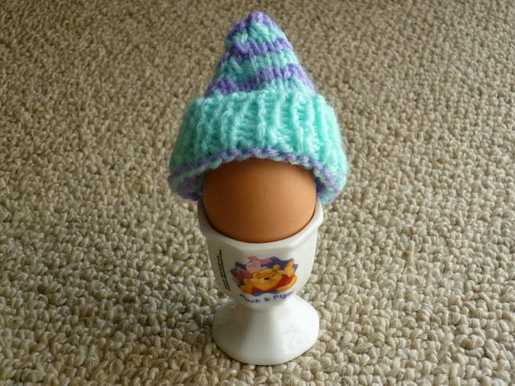
These are very cute, very quick and very cheap because they use up scraps of wool. You don't need to be an experienced knitter to whip up these cute little egg cosies, they are easy enough for beginners.
Breakfast on Easter Sunday (or any day for that matter) will be special when you present the boiled eggs with their hats on.
You will need:
4mm knitting needles
8 ply yarn - only a small amount is needed, so scraps are ideal
Wool needle to sew in the ends
These instructions are for a single colour cosy. You can work the cosy in stripes in any combination you like. The cosy in the picture is done in green and purple, my niece's favourite colours, ready for her Easter egg.
To make your egg hat:
Cast on 34 stitches
Knit 8 rows k1, p1 rib
Knit 8 rows stocking stitch
Next row: Purl
Next row: K1, *K6, K2 together - repeat from * to end
Next row: Purl
Next row: K1 *K5, K2 together - repeat from * to end
Next row: Purl
Next row: K1 *K4, K2 together - repeat from * to end
Next row: Purl
Next row: K1 *K3, K2 together - repeat from * to end
Next row: Purl
Next row: K1, *K2, K2 together - repeat from * to end
Next row: Purl
Next row: K1, *K1, K2 together - repeat from * to end
Next row: Purl
Next row: *K2 together - repeat from * to end
Next row: Purl
Repeat last two rows until you have no stitches left.
Tie off.
With right sides together, stitch centre seam.
Turn to right side, fold up ribbed band.
These little hats are really quick to knit, I did this one in about an hour! I was even able to watch a show I had recorded over the weekend while I knitted. You can't get much easier than that.
From Debt Free, Cashed Up and Laughing
Breakfast on Easter Sunday (or any day for that matter) will be special when you present the boiled eggs with their hats on.
You will need:
4mm knitting needles
8 ply yarn - only a small amount is needed, so scraps are ideal
Wool needle to sew in the ends
These instructions are for a single colour cosy. You can work the cosy in stripes in any combination you like. The cosy in the picture is done in green and purple, my niece's favourite colours, ready for her Easter egg.
To make your egg hat:
Cast on 34 stitches
Knit 8 rows k1, p1 rib
Knit 8 rows stocking stitch
Next row: Purl
Next row: K1, *K6, K2 together - repeat from * to end
Next row: Purl
Next row: K1 *K5, K2 together - repeat from * to end
Next row: Purl
Next row: K1 *K4, K2 together - repeat from * to end
Next row: Purl
Next row: K1 *K3, K2 together - repeat from * to end
Next row: Purl
Next row: K1, *K2, K2 together - repeat from * to end
Next row: Purl
Next row: K1, *K1, K2 together - repeat from * to end
Next row: Purl
Next row: *K2 together - repeat from * to end
Next row: Purl
Repeat last two rows until you have no stitches left.
Tie off.
With right sides together, stitch centre seam.
Turn to right side, fold up ribbed band.
These little hats are really quick to knit, I did this one in about an hour! I was even able to watch a show I had recorded over the weekend while I knitted. You can't get much easier than that.
From Debt Free, Cashed Up and Laughing
Soap Sack Instructions
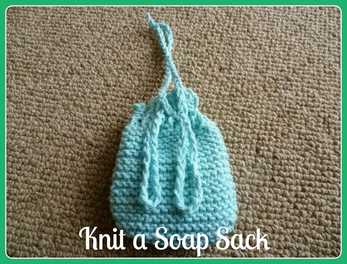
Here is a quick and easy gift idea that's not only pretty but useful too. Just slip a cake of soap into this handy soap sack and use it as you would a loofah mitt.
Materials:
Scraps of knitting cotton or bamboo (I used Bernat Big Ball, the same cotton I use to knit my dishcloths and Patons bamboo yarn - they work out to about the same price. Bamboo is much softer, so ideal for this project.)
1 pair 5mm knitting needles
1 darning needle
Instructions:
Cast on 40 stitches.
First row: *K 1, P 1, repeat from * to end
Second row: *P1, K1, repeat from * to end
Repeat first and second rows twice (6 rows)
Seventh row: *Knit 1, slip 1, yarn forward, pass slipped stitch over, repeat from * to end.
Eighth row: *P1, K1, repeat from * to end
Ninth row: *K1, P1, repeat from * to end
Repeat eighth and ninth rows once
Next row: Slip 1, knit to end. Repeat first row until work measures approximately 12cm.
First shaping row: Knit 1, knit 2 together, knit 15, knit 2 together twice, knit 15, knit 2 together, knit 1.
Second shaping row: Knit 1, knit 2 together, knit 13, knit 2 together twice, knit 13, knit 2 together, knit 1.
Third shaping row: Knit 1, knit 2 together, knit 11, knit 2 together twice, knit 11, knit 2 together, knit 1.
Fourth shaping row: Knit 1, knit 2 together, knit 9, knit 2 together twice, knit 9, knit 2 together, knit 1 - 24 stitches.
Cast off.
To make up: Fold soap sack in half. Sew up along the bottom and side seam.
Make a twisted cord from the same cotton and thread through the holes at the top of the sack.
Insert a cake of soap, draw up cord and tie in a bow.
This little sack took about 2-1/2 hours to knit while I was watching Miss Marple and Miss Fisher's Murder Mysteries on TV. It's so simple, the perfect little craft to keep fingers busy without having to concentrate on a complicated pattern. .
From Debt Free, Cashed Up and Laughing
Knitting Tip
When knitting on a set of four needles, use Blutac to stop stiches falling off the ends of the needles not in use. Being new to this kind of knitting I was concentrating so hard on what I was doing that I didn't notice stitches falling off elsewhere in the round.
- Contributed by Linda Shakiba, 10th September 2012
- Contributed by Linda Shakiba, 10th September 2012
A Basic Knitted Dishcloth
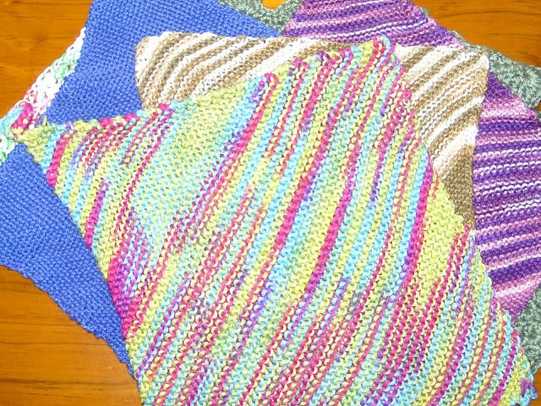
I love my knitted dishcloths. They are incredibly tough on stubborn kitchen "gunk" yet gentle on my good china and glassware. They are also very therapeutic to knit, easy to. I use cotton or bamboo to knit my dishcloths, which may seem expensive. The advantage is that they outlast bought sponges, can be bleached (if necessary), stand up to prolonged use and once they've been used in the kitchen and passed on to the laundry and bathroom they are put in the garage to use on the cars, where they are the best thing for scrubbing bugs off the duco without chemicals or damaging the paintwork.
Even a beginner can knit a dishcloth, this basic pattern is in simple garter stitch and can be finished in one or two nights in front of the television.
You will need:
3.75mm knitting needles
1 ball 8 ply crochet cotton
Pattern:
Cast on 44 stitches.
First row: Slip first stitch, knit to end. Turn.
Second row: Slip first stitch, knit to end. Turn.
Repeat these two rows another 42 times, making 88 rows in total.
Cast off. Weave ends in.
Contributed by Cath Armstrong
Even a beginner can knit a dishcloth, this basic pattern is in simple garter stitch and can be finished in one or two nights in front of the television.
You will need:
3.75mm knitting needles
1 ball 8 ply crochet cotton
Pattern:
Cast on 44 stitches.
First row: Slip first stitch, knit to end. Turn.
Second row: Slip first stitch, knit to end. Turn.
Repeat these two rows another 42 times, making 88 rows in total.
Cast off. Weave ends in.
Contributed by Cath Armstrong
Easier Knitting
Knitting the first row of your project can be a little slow because the stitches are usually quite tight. To solve this problem use two needles when casting on instead of one. The extra width of the two needles ensures that the stitches of the first row will be able to be knitted easily. Alternately you could use a knitting needle that is several sizes larger than the one needed in your project to achieve the same result.
- Contributed by Zofia Vandenburg, 9th January 2011
- Contributed by Zofia Vandenburg, 9th January 2011
